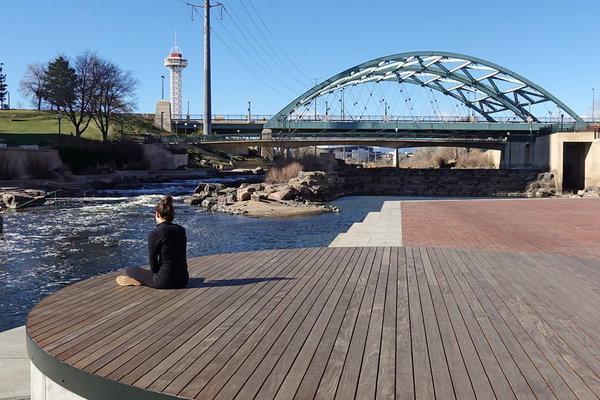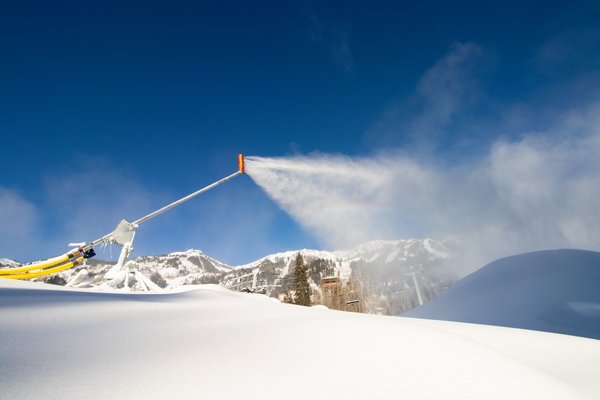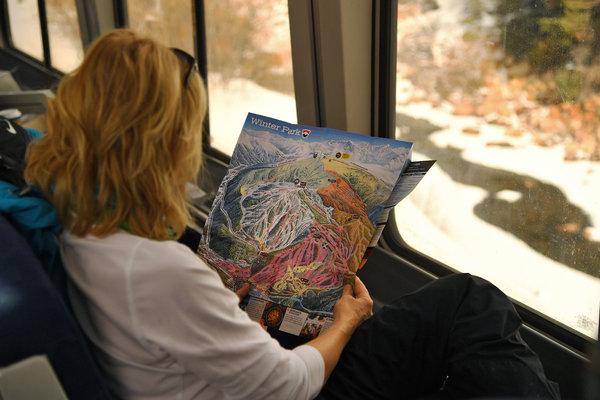The plan was simple: Take the train to the ski slopes.
Why? Trains are romantic. Trains are relatively climate-friendly. And I had recently spent an hour and a half on a perfect powder day sitting in traffic, trying to drive up Little Cottonwood Canyon to Snowbird, near Salt Lake City.
So I decided to swear off car travel for a weekend of skiing and snowboarding via the rails.
Two developments in Denver made the scheme possible: In 2016 the city opened the A line train, which runs from Denver International Airport to Union Station, an exquisitely restored Beaux-Arts terminal and the city’s main transit hub, in 37 minutes.
The following year, Amtrak launched its service on the Winter Park Express, a snow-season train that leaves Union Station each weekend and delivers passengers to the base of the Winter Park Resort, a burly, 3,000-acre ski mountain about 70 miles outside Denver.
Getting to the mountain, and the other resorts west of Denver by car is increasingly an issue. On a snowy weekend, traffic on I-70, the main route to the mountains, can turn an hour-and-a-half drive to Winter Park into a four-hour ordeal. Perhaps not surprisingly, many of the Winter Park Express’s trips sell out, with 400 passengers choosing to ride the rails each trip.
Or, as 8-year-old Sophia Sprinkle, who rode the train on a recent weekend with her mother and her mother’s boyfriend, said, “I like it a lot because it goes really fast.”
One city, three trains to the airport
It was admittedly a harebrained exercise. I had to fly to Denver and back, and spend a night in a hotel there at either end of the ski weekend, making for an expensive two days on the slopes. But I decided to consider it as research for a possible longer trip.
The journey began on a Friday afternoon in New York City, which lacks what travel planners call a “one-seat ride” to the airport. I slalomed down the subways stairs with my skis and gear as commuters streamed up, then rode a urine-perfumed elevator to the platform to meet my friend Julie at Penn Station. A standing-room-only Long Island Rail Road train took us to Jamaica station, the terminus of the AirTrain, where we once again had to schlep our gear to a new platform to get to the terminal for our four-hour-and-47-minute flight (which sat on the tarmac for an hour and a half after our scheduled departure).
In Denver, things looked up: As we walked out of the airport with our gear, the train to Union Station was on the tracks, its countdown clock showing 0.0 minutes to departure. I broke into a run, but the helpful conductor held the door and we slipped on with no seconds to spare.



After a too-short night in the Hotel Indigo Denver Downtown, across the street from Union Station, we boarded the ski train a little before 7 a.m. It was already filling up with ski-pants-clad passengers, most of them headed to the mountain for the day. Skis and bags went into a luggage area, and a friendly volunteer from Colorail, the Colorado Rail Passenger Association, helped us find seats.

A passenger examines a map of the Winter Park Resort ski area on the train.CreditJamie Schwaberow for The New York Times
The original Colorado ski train was created by the Denver and Rio Grande Western Railroad in 1940 to carry members of the Eskimo Ski Club to the mountain. The tradition continued until 2009, when the DRGW, which had changed hands several times by then, was sold again, and the new owners shut it down, selling off the cars to a Canadian outfit, as if to put a spike in the idea that it might return.
But train enthusiasts do not give up easily. In the fall of 2014, a member of Colorail called for the ski train’s revival in the group’s newsletter. Brad Swartzwelter, an Amtrak conductor who, as a boy, had gone fishing and hiking in the woods not far from the train tracks in Granby, Colo., put together a business plan, which Colorail pitched to Amtrak.
Test runs began in March 2015 and by January 2017, after some improvements to the platform at the ski resort, the Winter Park Express was in business.
Its eight cars — double-decker Superliners — are usually used on overnight trains in the West, like the California Zephyr or the Southwest Chief, but in the winter, when rider numbers on the big trains decline, the cars can be lent to the ski train. Mr. Swartzwelter is the conductor, checking tickets and offering a running commentary over the train’s public address system.
To the mountains
After leaving Denver at 7 a.m. sharp, the Express rolled through the suburb of Arvada and across a wide grassland plain, where it climbed a series of 10 curves toward the mountains of the Front Range. As the terrain got steeper, the train wound through massive slabs of rock that seemed almost close enough to touch. In the lounge car, the bartender, Darrell Bennett, was playing Tracy Chapman and doing a brisk business in Bloody Marys. After a section along South Boulder Creek, the train reached the 6.2-mile Moffat Tunnel. For the day-trippers, that was the signal to put their ski boots on; in 10 minutes we were at the base of the mountain. Nine a.m., right on time.
We cheated on our anti-car resolve and rode a hotel shuttle bus to the front desk of the Zephyr Mountain Lodge, where we stowed our bags, since our room in a nearby condominium wouldn’t open up until the afternoon. Within half an hour we were in line for the gondola. The mountain seemed to fit into the theme of the trip, with runs named Trestle (an Expert bump run with one seriously steep section), Brakeman and Derailer. Winter Park has never had the cachet of mountains like Vail and Aspen, and its devotees seemed to have a bit of a chip on their shoulders: “Vail Sucks” stickers were plastered on many available surfaces in the lift lines.
Julie and I split up for a while. Did I notice, she asked when we got back together, that everyone here seemed to be talking about smoking weed?
That night we cheated again and took a shuttle bus into the nearby town of Winter Park for fish tacos at a bustling joint called Pepe Osaka’s, where we sat at the bar and watched motor sports on TV. As we waited in the falling snow for a shuttle home, the people next to us casually lit up a joint.
The next day was a skier’s dream. It had snowed all night and just kept going. My skis floated through inches of powder as we danced down the bowls and tree-lined slopes off the Panoramic Express lift. The day was punctuated by cries of “yee-hah” from our fellow skiers — and maybe from me as well.
And home again
Around 3:30 p.m., I called it a day and went back to the condo to pick up our gear. Another quick shuttle ride took us back to the platform and the waiting train. Every seat was taken. There were numerous family groups — Emily Rice and her husband, from Chesapeake, Va., were visiting her parents, and her father, who had never been to Winter Park, had arranged the outing for them all. They hadn’t even skied. “I love taking the train,” she said.
Another group was celebrating a birthday — they had a cooler of beer for the ride back.
John Blood was on the train with his family, including his two young children, and another couple and their children. Why had they taken the train? “I-70,” he said. Well, part of the appeal was “little kids who like trains,” he added, though at $200 for a family, the ride was not a viable alternative to the highway, he said.
As we rode out of the mountains, Mr. Swartzwelter talked about the train — how it got 400 passenger-miles per gallon of diesel fuel, what he does while the train is at Winter Park — “fix things” and rest, since he gets up at 4 a.m. to get the train rolling in the morning.
Then he pulled out his smartphone, tapped on Google Maps and traced his finger along the path of I-70 where traffic was backed up for miles. “See all the red?” he asked. I did. And I was happy to be on the train.
If You Go
This ski season, the Winter Park Express ran every Saturday and Sunday, leaving Union Station at 7 a.m. on the way out, and returning from Winter Park at 4:30 p.m. The train also ran on the first two Fridays of each month, letting skiers spend a long weekend on the mountain. Tickets range from $29 to $59 per person each way, depending on how far in advance they are purchased. Children 2 through 12 are half-fare with an adult. The Winter Park Express runs this year through March 31.
The A Line from the airport to Union Station, Denver, takes 37 minutes and costs $10.50 per ride. Tickets can be purchased using the RTD app on your phone.

The Hotel Indigo Denver Downtown is just across the street from Union Station at 1801 Wewatta Street. A room with two queen beds was $153.95, including taxes, using the Booking.com app.
At Winter Park, a studio in the Founders Pointe condominium at the base area with one queen bed and a pull out couch was $280.12, including taxes.
The Crawford Hotel occupies what used to be office space within Union Station itself. You check in at a nook off the main waiting room. A double queen room recently cost about $278 a night booked through the hotel, $351.95 with taxes and fees. The hotel does not have its own bar or restaurants, but has access to those in the station, including the Cooper Lounge on the mezzanine, which offers a view over the waiting room along with craft cocktails.
Amy Virshup is the editor of the Travel section.
52 PLACES AND MUCH, MUCH MORE We have a new 52 Places traveler! Follow Sebastian Modak on Instagram as he travels the world, and discover more Travel coverage by following us on Twitter and Facebook. And sign up for our Travel Dispatch newsletter: Each week you’ll receive tips on traveling smarter, stories on hot destinations and access to photos from all over the world.
See also
https://www.your-rv-lifestyle.com/things-to-do-in-colorado/






